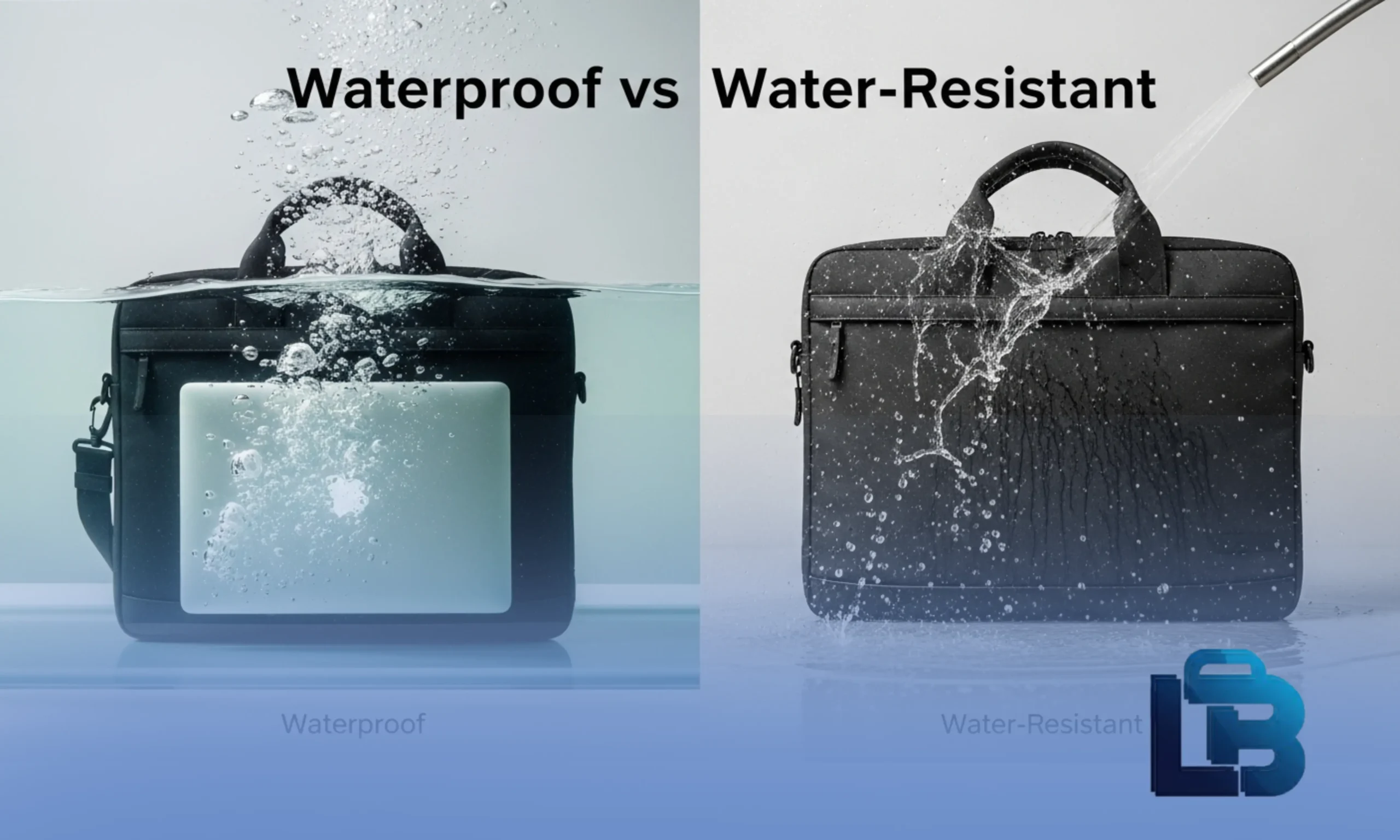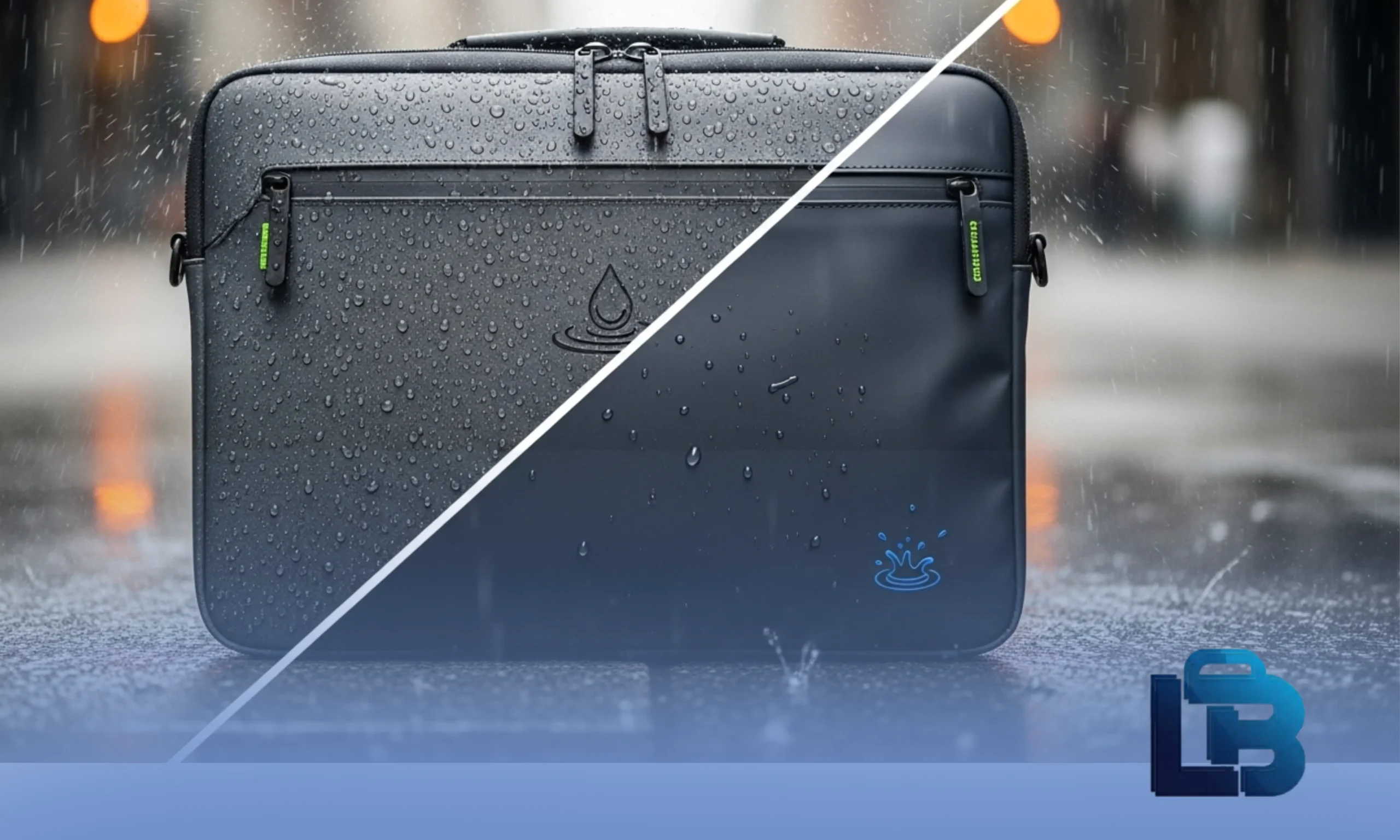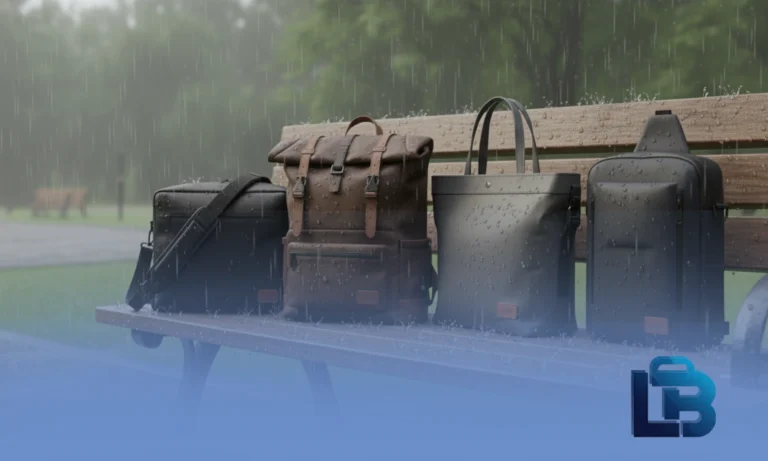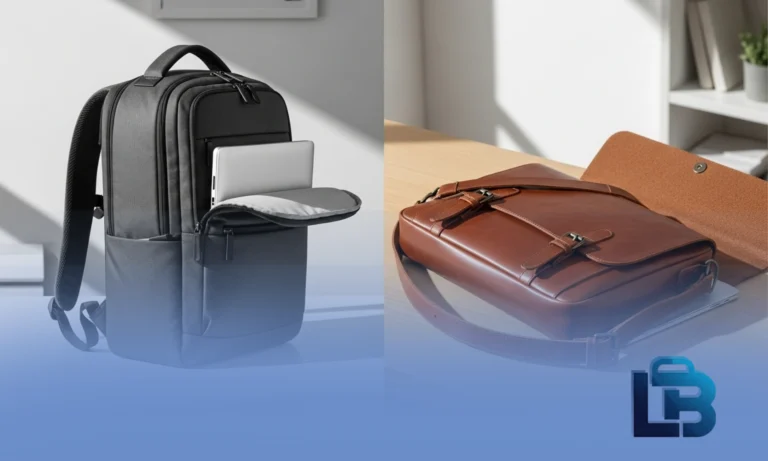Waterproof vs Water-Resistant Laptop Bags: Ultimate Guide
Being caught in the rain while carrying your laptop can turn a normal day into a disaster. You’re a student rushing to class, a commuter on your way to work, or a traveler exploring new places — your laptop is always with you, and keeping it safe from water damage is crucial. Imagine a sudden downpour soaking your backpack, ruining your laptop, and destroying important documents. It’s a nightmare every tech user wants to avoid.
One of the most common questions buyers face is: Should I choose a waterproof or a water-resistant laptop bag? At first glance, the terms may seem similar, but the difference can make or break your device’s safety. Understanding it can save your expensive laptop, gadgets, and documents from water damage.
At LaptopBag.pk, we’ve tested and reviewed hundreds of bags available in Pakistan and worldwide. This guide gives a clear, practical comparison to help you pick the right bag with the level of water protection you truly need.
What Is the Difference Between Waterproof and Water-Resistant Laptop Bags?
Let’s start with the basics.
| Feature | Waterproof Laptop Bags | Water-Resistant Laptop Bags |
| Protection Level | Complete protection against water; prevents water from entering. | Resists light rain or splashes but is not fully waterproof. |
| Material Used | PVC, TPU, tarpaulin, or coated nylon. | Polyester, canvas, or treated fabrics. |
| Seam Design | Heat-sealed or welded seams. | Stitched seams with water-resistant coating. |
| Zippers | Waterproof zippers (TPU sealed). | Water-resistant or covered zippers. |
| Ideal Use | Heavy rain, outdoor travel, hiking, and boating. | Daily use, mild rain, short commutes. |
In Simple Terms:
- Waterproof means no water gets in — ever.
- Water-resistant means it can handle some moisture, but not prolonged exposure.

Science Behind Water Protection
1. Water-Resistant Technology
Water-resistant laptop bags are made with fabrics that repel water droplets to a certain degree. These materials have a special Durable Water Repellent (DWR) coating that prevents light rain from soaking the fabric.
However, if you’re caught in heavy rain for more than a few minutes, moisture may eventually seep through the seams or zippers.
Common Materials:
- Polyester (600D, 900D)
- Nylon (Oxford fabric)
- PU-coated canvas
Example:
A polyester water-resistant laptop backpack is perfect for everyday use — office, college, or short trips. It resists light drizzle but shouldn’t be exposed to continuous rainfall.
2. Waterproof Technology
Waterproof laptop bags are made using impermeable materials that block all forms of water penetration. These bags usually undergo IPX (Ingress Protection) testing to ensure they can withstand immersion or heavy downpour.
Key Features:
- Welded seams instead of stitched ones.
- Waterproof zippers with rubber or TPU coating.
- Roll-top closures to seal the bag completely.
Common Materials:
- PVC (Polyvinyl Chloride)
- TPU (Thermoplastic Polyurethane)
- Tarpaulin or Vinyl-coated fabrics
Example:
A TPU waterproof dry bag is ideal for travelers, bikers, and adventurers who need total protection for laptops, cameras, and documents during unpredictable weather or water exposure.
Durability Comparison
| Aspect | Waterproof | Water-Resistant |
| Longevity | Very durable, especially for outdoor conditions. | Good for daily use, but the coating may wear off. |
| Maintenance | Requires less frequent cleaning. | Needs re-coating after long use. |
| Weight | Slightly heavier due to thicker material. | Lightweight and easier to carry. |
| Comfort | May feel rigid. | More flexible and breathable. |
Verdict:
If comfort and style matter more, go for water-resistant.
If protection and durability matter more, choose waterproof.
Design & Functionality: What Really Matters
When choosing between waterproof and water-resistant laptop bags, you should look beyond the label. Pay attention to these design aspects:
1. Zippers and Closures
- Waterproof zippers are sealed with TPU or rubber layers.
- Water-resistant zippers are covered with flaps or coatings but may still leak under pressure.
2. Seams
- Welded seams prevent water entry completely.
- Stitched seams can let moisture in if not properly sealed.
3. Compartments
- Waterproof bags usually have fewer compartments (to maintain sealing).
- Water-resistant bags offer multiple pockets and organizers, perfect for students or professionals.
4. Style and Aesthetics
Waterproof bags often look rugged or sporty, while water-resistant ones come in elegant office styles or casual designs. Choose based on your environment — office, travel, or outdoor use.
Use Cases: When to Choose Each Type
| Use Case | Recommended Bag Type | Reason |
| Daily Office Commute | Water-Resistant | Protects from light rain and splashes. |
| Student or University Use | Water-Resistant | Lightweight and affordable. |
| Motorbike or Cycle Riders | Waterproof | Can handle sudden downpours. |
| Outdoor Travel or Hiking | Waterproof | Keeps devices safe from rain or water exposure. |
| Photography / Fieldwork | Waterproof | Offers high protection for electronics. |
| Casual City Use | Water-Resistant | Stylish and practical for daily life. |
Materials Breakdown: Which One Performs Best?
1. Polyester
- Used in: Water-resistant laptop bags
- Pros: Affordable, lightweight, strong
- Cons: Loses coating over time
- Best for: Students and office workers
2. Nylon
- Used in: Water-resistant & semi-waterproof bags
- Pros: Flexible, durable, dries quickly
- Cons: Needs DWR treatment regularly
- Best for: Commuters and travelers
3. TPU (Thermoplastic Polyurethane)
- Used in: Waterproof laptop bags
- Pros: Fully waterproof, resistant to tearing
- Cons: Expensive, less stylish
- Best for: Outdoor adventurers
4. Tarpaulin / PVC
- Used in: High-end waterproof backpacks
- Pros: Heavy-duty, weatherproof
- Cons: Heavy, not breathable
- Best for: Extreme weather conditions
How to Verify if a Laptop Bag Is Truly Waterproof or Just Water-Resistant (For Material-Savvy Buyers)
If you already know a bit about bag materials and coatings, you can easily verify whether a bag is genuinely waterproof or simply water-resistant. Here’s a detailed material-based inspection checklist you can follow before buying:
1. Feel the Fabric Surface
- Waterproof materials like TPU, PVC, or tarpaulin have a slightly rubbery or plasticky texture that feels smooth and non-porous.
- Water-resistant fabrics like polyester or nylon feel woven and breathable. If you can sense the fabric’s weave or texture, it’s likely only water-resistant.
2. Inspect the Inner Coating
- Turn the bag inside out or look inside any pocket.
- Waterproof bags will have a visible laminated layer (like a thin film or glossy coating).
- Water-resistant bags might show a dull inner layer with fabric visible beneath.
- The waterproof coating often reflects light slightly — almost like a matte plastic layer fused to the fabric.
3. Check the Stitching and Seams
- Waterproof bags: Seams are heat-sealed, glued, or welded, meaning you won’t see the usual thread stitches.
- Water-resistant bags: You’ll see stitch lines, sometimes covered with narrow tape for extra resistance — but they’re not completely sealed.
4. Examine Zippers and Closures
- Look closely at the zipper teeth:
- Waterproof zippers are covered with a TPU or rubber lining that seals tightly when zipped.
- Water-resistant zippers may have a fabric flap covering them, but are not fully sealed.
- Run your finger along the zipper — a slightly stiff, rubbery movement usually means waterproof protection.
5. Conduct a Simple Water-Drop Test
If possible, do a quick test:
- Sprinkle a few drops of water on the outer surface.
- Observe for 10–15 seconds.
- If the water beads up and rolls off completely, the bag is water-resistant.
- If the droplets stay on top without soaking in, it may be waterproof — especially if the inside remains dry after a minute.
- If the fabric darkens or absorbs water, it’s not water-protected at all.
6. Look for Material Labels or Tags
- Waterproof materials are usually labeled PVC-coated, TPU-laminated, or IPX-rated.
- Water-resistant ones might mention PU-coated polyester, DWR-treated nylon, or simply say “splash-resistant.”
7. Flexibility Test
- Bend or press the fabric gently.
- Waterproof fabrics may feel stiff and less foldable.
- Water-resistant fabrics bend easily without resistance.
This flexibility difference helps identify whether a protective coating or lamination is present.
8. Smell Test (for Experts)
Yes — even smell can reveal clues:
- PVC and TPU materials often have a mild synthetic or rubber smell.
- Water-resistant fabrics smell more like textile or polyester.
While not a scientific test, experienced buyers often use it to verify coating types.
Expert Tip:
If you buy online, always zoom in on product photos to see the texture, zipper type, and inner lining. Sellers often mention “waterproof” in titles, but real proof lies in the material specification and seam construction mentioned in the description.
Comfort and Usability Comparison
| Feature | Waterproof Bag | Water-Resistant Bag |
| Weight | Slightly heavy | Lightweight |
| Breathability | Low | High |
| Style | Sporty, outdoor | Modern, urban |
| Storage Space | Limited | Multiple compartments |
| Ease of Cleaning | Easy to wipe | May absorb stains |
Expert Tip:
For office or academic use, water-resistant bags offer practicality. For field jobs, photography, or outdoor travel, waterproof bags are the right investment.
Maintenance & Care Tips
For Waterproof Bags:
- Clean with a damp cloth — avoid harsh detergents.
- Store in a cool, dry place to prevent cracks.
- Lubricate zippers occasionally to prevent stiffness.
For Water-Resistant Bags:
- Reapply DWR spray every few months.
- Don’t machine wash — hand clean with mild soap.
- Keep away from direct heat or sunlight for long periods.
Price Comparison in Pakistan (2025 Update)
| Type | Price Range (PKR) | Example Models |
| Water-Resistant Laptop Bags | Rs. 2,000 – Rs. 6,000 | Lenovo B210, HP Pavilion Backpack, Dell Essential |
| Waterproof Laptop Bags | Rs. 5,000 – Rs. 12,000+ | Targus 15.6″ Waterproof, Tigernu Anti-Theft, Arctic Hunter TPU Bag |
Buying Tip:
If your budget is under Rs. 5,000 and you mostly use your laptop indoors or for commuting, go for a water-resistant bag.
If you travel or ride a bike daily, investing in a waterproof one will save you costly laptop repairs later.
How to Identify Genuine Waterproof Bags
There are many fake “waterproof” claims online. Here’s how to check authenticity:
✅ Look for IPX ratings (IPX5, IPX6, IPX7).
✅ Verify if the bag uses TPU-coated zippers.
✅ Ensure seams are welded, not stitched.
✅ Avoid cheap imitations that only have “waterproof coating.”
Pros and Cons Summary
Waterproof Laptop Bags
Pros:
- 100% protection from rain or water.
- Ideal for outdoor and travel.
- Durable and rugged design.
Cons:
- Heavier and costlier.
- Limited designs.
- Less breathable material.
Water-Resistant Laptop Bags
Pros:
- Affordable and lightweight.
- Stylish designs.
- Sufficient for daily protection.
Cons:
- Not suitable for heavy rain.
- Needs re-coating over time.
- Zippers and seams may leak.
Expert Recommendation
As experts in laptop accessories and materials, our team recommends the following:
For professionals, students, and office users:
Choose a high-quality water-resistant backpack made from 600D polyester or nylon. It is affordable, comfortable, and fits popular Dell, LB, and HP laptops.
For travelers, photographers, or bikers:
Go for a certified waterproof laptop bag made from TPU or tarpaulin material. It ensures protection even during unpredictable weather.
Environmental Impact & Sustainability
Waterproof materials like PVC and TPU are durable but less eco-friendly. However, many modern brands now use recycled polyester (rPET) and eco-coated nylon to make sustainable water-resistant bags.
If sustainability matters to you, prefer eco water-resistant laptop bags made with PFC-free coatings instead of traditional leather. Some brands even offer vegan leather and waterproof leather options that combine style with eco-consciousness.
Buying Guide: What to Look for When Choosing
When shopping for a laptop bag, always check these important features:
- Waterproof Rating (IPX5–IPX7) – For full protection against rain.
- Laptop Compartment Padding – At least 15mm foam to keep your Dell, HP, LB, or Lenovo laptop safe.
- Material Type – TPU > Nylon > Polyester (ranked best to basic).
- Comfort – Padded shoulder straps and an airflow back panel for backpack users.
- Extra Features – USB charging port, anti-theft pocket, reflective strips.
- Brand Reputation – Choose reliable or verified sellers with good ratings and reviews.
- Types and Sizes – 13”, 14”, and 15.6” sizes are most common for laptops in Pakistan.
- Backpack vs Shoulder – Backpacks are better for comfort, while shoulder bags look more formal.
- Price – Compare the price before buying; genuine value bags under Rs. 2000 are available for students and professionals.
Conclusion
To sum up, waterproof laptop bags are perfect for travelers, bikers, and outdoor users who need strong, weatherproof materials. In contrast, water-resistant laptop bags are ideal for students, professionals, boys, and girls who want lightweight, stylish, and affordable options, especially if looking for a laptop bag under Rs. 1000.
If your daily routine involves light commuting, office work, or school, choose a stylish water-resistant backpack as it is versatile and budget-friendly. However, if you often face unpredictable rain or work outdoors, a fully waterproof laptop bag made from TPU or tarpaulin is a smarter investment.
For those comparing waterproof vs leather bags, remember that leather looks elegant but isn’t weatherproof, so always prioritize function over fashion when protection matters most. The right choice depends on your lifestyle, type, and price range, ensuring your LB, Dell, or HP laptop stays safe wherever you go.
FAQs
Which is better, waterproof or water-resistant laptop bags?
If you travel often or face unpredictable rain, waterproof bags offer full protection. For everyday use or office work, a water-resistant product is more practical and affordable.
Can I wash a waterproof laptop bag?
No, it’s better to wipe it clean with a damp cloth. Machine washing can damage the waterproof materials and zippers.
Are waterproof bags completely safe in heavy rain?
Yes, as long as they have sealed seams and TPU-coated zippers. However, no fabric is 100% safe if submerged for hours.
How long does a water-resistant coating last?
Usually 6 to 12 months, depending on usage. You can reapply DWR spray to restore water resistance.
Which brands offer the best waterproof laptop bags in Pakistan?
LB, Targus, Tigernu, Arctic Hunter, Lenovo, HP, and Dell produce reliable waterproof and water-resistant bags, available at affordable prices both online and in stores.
Can I use a rain cover instead of buying a waterproof bag?
Yes, rain covers add an extra layer of protection and are very budget-friendly. But they may not be as convenient as built-in waterproofing, especially for backpacks.




